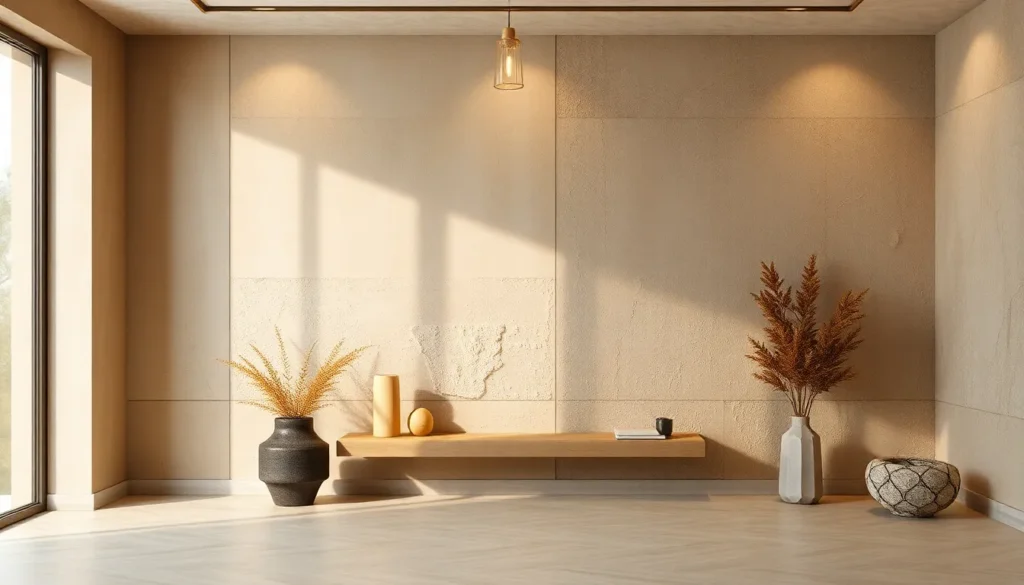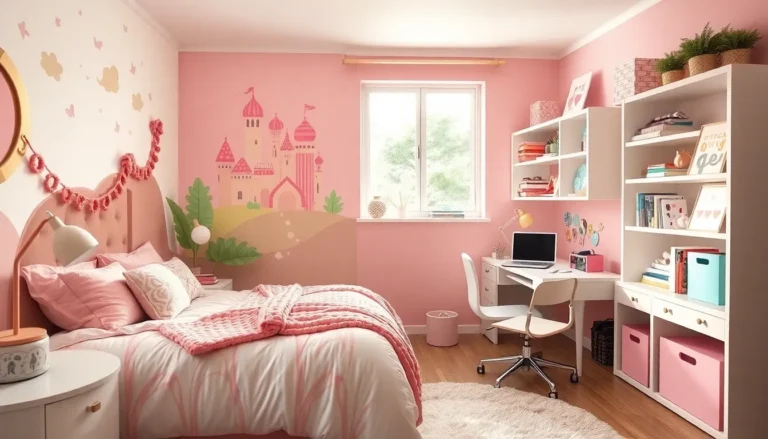Wall textures can transform a space from ordinary to extraordinary. They add depth and character, turning plain surfaces into stunning focal points. Whether it’s a sleek modern finish or a rustic charm, the right texture can enhance the overall aesthetic of any room.
Choosing the perfect wall texture involves understanding the various options available, from smooth plaster to rough stucco. Each texture brings its own style and feel, influencing the ambiance of the environment. As homeowners and designers seek innovative ways to express their creativity, wall textures are becoming an essential element in interior design.
Table of Contents
ToggleTypes Of Wall Textures
Wall textures come in various styles, each serving distinct purposes in interior design. Selecting the right texture enhances both aesthetics and functionality.
Smooth Finish
A smooth finish creates an elegant, clean look, suitable for modern and minimalist designs. It’s often achieved with plaster or paint, providing a sleek surface that reflects light. This texture allows for easy wall maintenance, making it ideal for spaces with high traffic or where artwork is displayed.
Textured Finish
A textured finish adds dimension and visual interest to walls. Common techniques include combing and swirling, which create patterns that catch the eye. This finish works well in casual settings, such as living rooms or family spaces, where a more relaxed ambiance is desired.
Knockdown Texture
Knockdown texture, also known as slap brush, offers a unique appearance with a blend of subtle relief and flatter areas. Created by partially flattening a spray-applied texture, this style adds rugged charm. It’s often utilized in ceilings and walls, providing both an artistic touch and sound absorption benefits.
Stucco Texture
Stucco texture features a rough and durable finish, traditionally used in exterior applications but increasingly found indoors. Its thick, textured surface lends a rustic appeal, making it ideal for Mediterranean or southwestern-themed designs. This texture also enhances insulation, contributing to energy efficiency in the home.
Benefits Of Using Wall Textures

Wall textures enhance a room’s overall look and function, making them a popular choice among designers and homeowners. These textures serve various purposes, from aesthetic enhancement to practical benefits.
Aesthetic Appeal
Aesthetic appeal ranks high among the benefits of wall textures. Textures provide visual interest and depth, transforming a plain wall into a focal point. Options like smooth finishes convey elegance, while rough textures add a rustic touch. The combination of different textures can create a unique style that complements the room’s theme, enhancing the overall atmosphere.
Durability
Durability is another significant advantage of wall textures. Textured surfaces often resist wear and tear better than smooth finishes, making them ideal for high-traffic areas. Materials like stucco and textured paint often endure moisture and scratches, prolonging the lifespan of the walls. This durability can reduce maintenance costs and the need for frequent repainting, ensuring a long-lasting aesthetic.
Acoustic Properties
Acoustic properties also play a crucial role in the benefits of wall textures. Textured walls can absorb sound, decreasing the chances of echo and creating a more pleasant environment. This quality becomes particularly important in busy homes, offices, or urban settings, where noise control enhances comfort. Different textures can be strategically chosen to optimize sound absorption based on the specific needs of each room.
Popular Wall Texture Techniques
Several wall texture techniques can enhance the visual impact of interior spaces, allowing for a range of styles and finishes. Below are three popular methods used to create unique wall textures.
Sponge Technique
The sponge technique involves using a sponge to apply paint and achieve a textured effect. This method creates a soft, mottled appearance by dabbing a sponge in paint and pressing it against the wall. The results vary based on the paint colors and sponging technique. Often, this technique works well with two or more colors that complement each other, providing depth and visual interest.
Brush Technique
The brush technique employs a special brush to create linear patterns on the wall’s surface. By employing a dry brush and varying the amount of paint, this method results in beautiful streaks or striations. Common uses include creating a faux finish that mimics wood grain or adding depth through light and shadow. The brush technique provides versatility, allowing for both subtle and bold designs.
Trowel Technique
The trowel technique uses a drywall trowel or putty knife to apply texture compound directly onto the wall, producing a distinctive 3D effect. This method often involves spreading a thick layer of compound, which can then be manipulated for different patterns, such as swirls or knockdown textures. Its durable finish enhances the tactile quality of the walls while adding significant character to the spaces.
Choosing The Right Wall Texture For Your Space
Selecting the right wall texture significantly influences the functionality and aesthetics of a room. It’s essential to consider both room functionality and interior style when making a decision.
Consider Room Functionality
Room functionality plays a vital role in determining the appropriate wall texture. High-traffic areas like hallways or children’s playrooms benefit from durable textures, such as knockdown or stucco, which resist wear and tear. On the other hand, spaces designated for relaxation and socialization might suit smoother textures that create a calming atmosphere. For instance, smooth plaster can evoke sophistication in living rooms and dining areas, while textured finishes offer better sound absorption in open-concept spaces, enhancing the overall comfort. Assessing how the space will be used can guide texture selection to ensure practicality and appeal.
Match Your Interior Style
Matching wall texture to the interior style creates a harmonious design. Modern interiors often favor sleek, smooth finishes, providing a minimalist backdrop for furniture and decor. Conversely, rustic or Mediterranean styles incorporate rough stucco textures to enhance warmth and character. Eclectic styles embrace a mix of textures, allowing creativity to shine. Choosing a texture that resonates with the overall theme unifies the design elements, ensuring that the walls complement the furnishings, color schemes, and architectural features. Identifying the desired aesthetic before selecting a texture facilitates a cohesive and inviting environment.
Maintenance Tips For Wall Textures
Maintaining wall textures ensures their longevity and aesthetic appeal. Proper care helps preserve their integrity and keeps them looking pristine.
Cleaning Methods
Regular cleaning maintains the appearance of textured walls. Use a soft, dry cloth or a duster for routine dusting. For stubborn stains, create a mixture of mild soap and water, then gently scrub the affected area with a soft sponge. Ensure that excess moisture doesn’t build up, as this can damage the texture. For specific textures like stucco, a soft-bristled brush effectively removes dirt without compromising the surface.
Repairing Damaged Textures
Repairing damaged textures can restore the wall’s original look. For minor nicks in textured surfaces, fill in the area with a matching texture compound using a putty knife, smoothing it to blend with the surrounding surface. Allow the compound to dry completely before applying paint if necessary. For larger damages, removing the affected section and reapplying the appropriate texture technique may prove necessary to achieve a seamless finish. Always match the repair technique to the existing texture type for uniformity.
Wall textures play a pivotal role in shaping the ambiance of interior spaces. They not only enhance visual appeal but also provide practical benefits that elevate a room’s functionality. By selecting the right texture, homeowners can create a harmonious environment that reflects their personal style and meets the demands of everyday life.
With various techniques available, from sponge to trowel, there’s endless potential for creativity. Proper maintenance ensures these textures remain vibrant and durable over time. Ultimately, wall textures are more than just decorative elements; they’re essential components that contribute to a room’s overall character and comfort.



